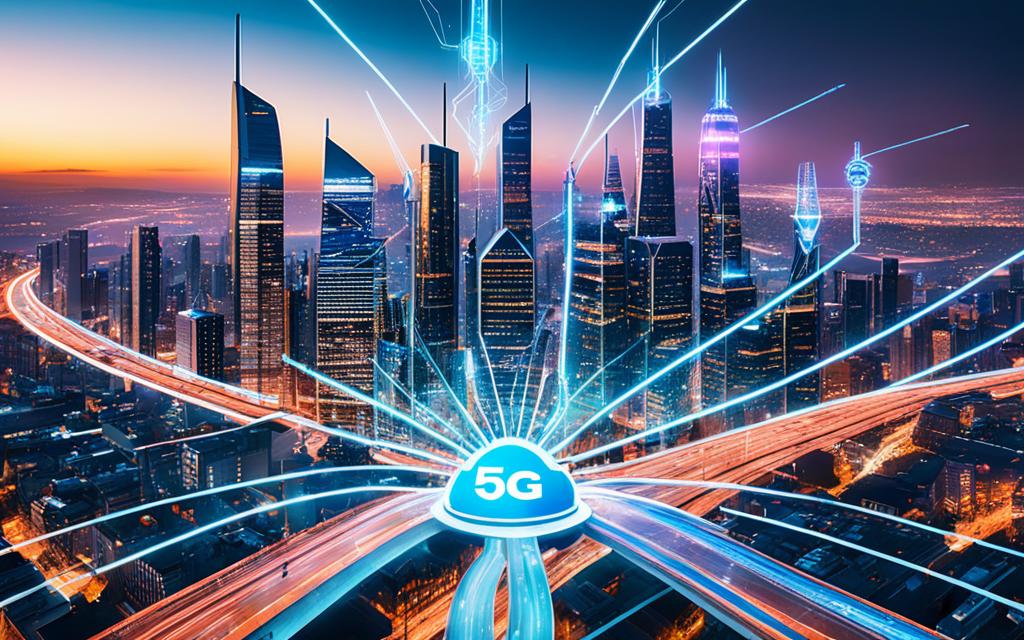Smart cities are rapidly evolving, revolutionizing urban living by leveraging advanced technologies to improve efficiency and enhance the quality of life for citizens. At the heart of this transformation lies the role of cellular networks in providing seamless connectivity and enabling the smooth functioning of various smart city applications.
In today’s digital age, connectivity is the cornerstone of urban efficiency, allowing cities to optimize resource allocation, streamline processes, and deliver innovative services to residents. With the proliferation of connected devices and the Internet of Things (IoT), cellular networks have emerged as a critical infrastructure to support the vast ecosystem of interconnected devices, sensors, and data platforms that make smart cities possible.
Unlike public wireless networks, such as cellular providers or public Wi-Fi hotspots, private wireless networks offer dedicated spectrum resources that ensure high-performance data transfer speeds and low latency connections between connected devices. This dedicated connectivity is paramount for supporting the advanced technology and mission-critical applications in smart cities.
Private wireless networks provide numerous advantages for smart cities, including enhanced performance capabilities, scalability options to accommodate future needs, lower deployment costs, and secure connections with enterprise-grade security features. Different types of private wireless network solutions, such as LTE, 5G, Wi-Fi 6, and mesh networks, offer various advantages in terms of speed, coverage, scalability, security, and cost, allowing cities to choose the most suitable option for their specific needs.
To fully realize the potential of smart cities, it is crucial to consider implementing private wireless networks that can support the evolving technological landscape. However, factors such as network capacity, technology selection, scalability, reliability, coverage, and security must be carefully evaluated to ensure successful implementation and operation of these networks in smart city initiatives.
In conclusion, cellular networks play a pivotal role in building smart cities by providing the connectivity required for seamless coordination and communication between various smart city components. As cities continue to evolve and embrace technological advancements, private wireless networks and cellular connectivity will continue to play a vital role in driving urban efficiency and connecting citizens to a smarter future.
Advantages of Private Wireless Networks in Smart Cities.
Private wireless networks offer a range of benefits that make them ideal solutions for supporting new technology and mission-critical applications in smart cities. These networks provide advantages such as:
- Enhanced Performance Capabilities: Private wireless networks offer high-speed data transfer and low latency connections, enabling fast and reliable communication between devices. This ensures efficient functioning of smart city applications and enhances user experiences.
- Scalability Options: Private wireless networks can easily scale to accommodate the growing needs of smart cities. As technology advances and new applications emerge, these networks can expand and adapt to handle increased data demands.
- Lower Deployment Costs: Implementing private wireless networks in smart cities can be more cost-effective compared to relying solely on public wireless networks. With private networks, municipalities have control over their network infrastructure, reducing dependence on costly cellular providers.
- Secure Connections: Private wireless networks offer enterprise-grade security features, ensuring the privacy and protection of data transmitted within the smart city ecosystem. These networks use advanced encryption protocols and authentication methods, safeguarding against potential cyber threats.
Different types of private wireless network solutions are available for smart cities, each with its own advantages and disadvantages:
| Network Solution | Advantages |
|---|---|
| LTE | Wide coverage, reliable connectivity, and compatibility with existing devices. |
| 5G | High-speed data transmission, increased capacity, and low latency rates. |
| Wi-Fi 6 | Faster speeds, improved capacity, and reduced network congestion. |
| Mesh Networks | Flexible deployment options, self-healing capabilities, and improved network resilience. |
By leveraging private wireless networks, smart cities can harness the advantages they offer to create efficient, connected, and sustainable urban environments.
The Impact of 5G Technology in Smart Cities.
The emergence of 5G technology presents a significant impact on the development and deployment of private wireless networks in smart cities. This cutting-edge technology offers exciting opportunities for municipalities and small businesses to establish cost-effective private LTE solutions, enabling them to achieve optimal connectivity within urban environments.
One of the key advantages of 5G technology is its ability to provide significantly higher speeds compared to its predecessor, LTE. With speeds of up to 1 Gbps, 5G facilitates faster data transfer, enabling smart cities to process and analyze vast amounts of information in real-time. This enhanced performance capability empowers various smart city initiatives such as traffic management systems, remote healthcare services, and intelligent energy grids.
Beyond speed, 5G also brings increased capacity, enabling smart cities to support a larger number of connected devices simultaneously. This is particularly crucial as the Internet of Things (IoT) continues to expand, with more devices requiring seamless connectivity. The greater capacity of 5G ensures a smooth and uninterrupted user experience, allowing citizens to access smart city applications without network congestion or latency issues.
While the adoption of 5G technology is still in its early stages, it holds immense promise for smart city initiatives. The complex infrastructure requirements and expensive equipment costs have been the primary barriers to widespread adoption. However, as 5G continues to mature, these obstacles are gradually overcome. The flexible nature of 5G technology allows private networks to evolve and adapt, providing smart cities with further opportunities to enhance their connectivity and create more efficient and sustainable urban environments.

Considerations for Implementing Private Wireless Networks in Smart Cities.
Implementing private wireless networks in smart cities involves careful consideration of various factors to ensure seamless connectivity and optimal performance. Here are key implementation considerations for private wireless networks in smart cities:
- Sufficient Network Capacity: Ensure that the network has sufficient capacity to handle the increasing number of connected devices and applications in a smart city environment. Scalability is crucial to accommodate future growth.
- Choosing the Right Network Technology: Select the appropriate network technology, such as LTE, 5G, Wi-Fi 6, or mesh networks, based on the specific requirements of the smart city. Each technology has its own advantages and considerations in terms of speed, coverage, scalability, security, and cost.
- Reliability and Coverage: Design the private wireless network with robust reliability and extensive coverage to avoid service disruptions that can impact the quality of life for citizens. A reliable and comprehensive network ensures seamless connectivity and efficient functioning of smart city applications.
- Security: Implement robust security measures to protect against data breaches and ensure the privacy of connected devices. Consider encryption protocols, authentication mechanisms, and intrusion detection systems to maintain the integrity and confidentiality of data transmitted over the network.
“Implementing private wireless networks in smart cities requires careful consideration of factors such as network capacity, technology selection, scalability, reliability, coverage, and security.”
By addressing these implementation considerations, smart cities can leverage the full potential of private wireless networks to enhance connectivity, improve efficiency, and deliver a seamless experience to their residents and businesses.
The Role of Cellular Connectivity in Smart City Infrastructure.
Cellular connectivity plays a central role in enabling the sophisticated network of interconnected devices, sensors, and data platforms within smart city ecosystems. It provides reliable and robust wireless communication, allowing for seamless connections between devices and ensuring data security. Cellular networks, such as 5G, support high-speed data transmission and low-latency communication critical for efficient functioning of IoT networks in smart cities. Centralized management of IoT devices through cellular networks facilitates scalability, digitalization, and enhanced security measures, making them ideal for smart city applications.

Benefits of Cellular Connectivity in Smart City Infrastructure
1. High-speed Data Transmission: Cellular networks, particularly 5G technology, provide faster data transfer rates, enabling real-time communication and data processing in smart city infrastructure.
2. Low-latency Communication: With low latency, cellular connectivity ensures minimal delays in data transmission, allowing smart devices to quickly respond to the changing needs of a smart city environment.
3. Scalability: Cellular networks offer the scalability needed to accommodate a growing number of IoT devices and expanding smart city applications. This scalability allows for the seamless integration of new technologies and services.
4. Enhanced Security Measures: Cellular connectivity provides robust security protocols, protecting smart city infrastructure from cyber threats. Centralized management of IoT devices through cellular networks enables consistent security measures and monitoring.
Use Cases of Cellular Connectivity in Smart City Infrastructure
- Smart Traffic Management: Cellular connectivity enables real-time traffic monitoring and control systems, optimizing traffic flow, reducing congestion, and improving road safety.
- Public Safety: By leveraging cellular networks, smart city infrastructure can enhance public safety through intelligent surveillance systems, emergency response coordination, and predictive analytics for crime prevention.
- Smart Energy Management: Cellular connectivity allows for the efficient monitoring and control of energy consumption in smart city buildings, contributing to energy conservation and sustainability goals.
- Environmental Monitoring: Cellular connectivity enables the deployment of sensors for monitoring air quality, noise levels, and other environmental factors, facilitating smarter and more sustainable urban planning.
- Smart Waste Management: By implementing cellular connectivity, smart city infrastructure can optimize waste collection routes, reduce landfill usage, and promote recycling practices, ensuring a cleaner and more sustainable environment.
Overall, cellular connectivity plays a vital role in the development of smart city infrastructure by enabling seamless communication, scalability, and enhanced security. It empowers cities to leverage IoT technologies and data-driven solutions to improve urban efficiency, sustainability, and the overall quality of life for its citizens.
Conclusion
The evolution of smart cities presents a transformative opportunity to enhance urban living through the implementation of private wireless networks and cellular connectivity. These networks offer advanced performance capabilities, scalability, and secure connections, making them ideal for supporting the implementation of new technologies and critical applications in smart cities. Various private wireless network solutions, such as LTE, 5G, Wi-Fi 6, and mesh networks, provide options to cater to the specific needs of smart cities, ensuring optimal outcomes.
Implementing private wireless networks in smart cities requires careful consideration of various factors to ensure success. These include network capacity, technology selection, scalability, reliability, coverage, and security. By taking these aspects into account, smart cities can establish robust and resilient wireless networks that accommodate the increasing demand for connectivity and support the seamless functioning of interconnected devices, promoting urban efficiency and connectivity.
The role of cellular connectivity in smart city infrastructure cannot be underestimated. Cellular networks, particularly the advanced capabilities of 5G technology, provide reliable wireless communication, facilitating seamless connections between devices and ensuring data security. With high-speed data transmission and low-latency communication, cellular networks support the efficient functioning of IoT networks in smart cities. Moreover, centralized management of IoT devices through cellular networks enables scalability, digitalization, and enhanced security measures, making them indispensable for smart city applications.
FAQ
What are the advantages of private wireless networks in smart cities?
Private wireless networks offer enhanced performance capabilities, scalability options, lower deployment costs, and secure connections with enterprise-grade security features.
How does 5G technology impact smart cities?
5G technology provides higher speeds, increased capacity, and lower latency rates, making it ideal for supporting new technology and mission-critical applications in smart cities.
What factors should be considered when implementing private wireless networks in smart cities?
Factors such as network capacity, choosing the right network technology, scalability, reliability, coverage, and security should be taken into consideration when implementing private wireless networks in smart cities.
What is the role of cellular connectivity in smart city infrastructure?
Cellular connectivity serves as the backbone of smart city infrastructure, enabling seamless connections between interconnected devices, sensors, and data platforms, and promoting urban efficiency and connectivity.



















